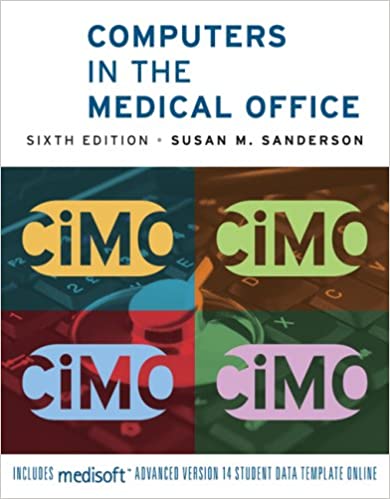
Computers in the Medical Office 6th Edition by Susan Sanderson
Edition 6ISBN: 978-0073401997
Computers in the Medical Office 6th Edition by Susan Sanderson
Edition 6ISBN: 978-0073401997 Exercise 15
Process a refund for a patient who has overpaid on his account.
Date: October 4, 2010
1. Open the Transaction Entry dialog box, if it is not already open.
2. In the Chart box, key SM, and press Tab to select James L. Smith.
3. Verify that Facial nerve paralysis is displayed in the Case box.
4. Notice that the entry in the Charges section of the window is highlighted in yellow, indicating that this is an overpaid charge. According to the patient's insurance plan, the plan pays 80 per cent of charges and the patient pays 20 percent. In this case, 20 percent of the charges ($210.00) would be $42.00. However, the patient paid $52.00, and is therefore due a refund of $10.00.
5. Click the New button in the Payments, Adjustments, and Comments section of the dialog box.
6. Accept the default entry of 10/4/2010 in the Date box.
7. Click in the Pay/Adj Code box. Select PTREFUND (the code for a patient refund), and press Tab.
8. Select Smith, James-Guarantor in the Who Paid box.
9. Enter Overpaid-refund in the Description box, and press Tab twice to get to the Amount box.
10. Enter 10 in the Amount box, and press Tab. Notice that the amount is listed as a positive amount.
11. The Unapplied Amount box should read $10.00.
12. Click in the Check Number box; enter 456; and press Tab.
13. Click the Apply button. The Apply Payment to Charges dialog box is displayed.
14. Notice that the amount of this refund ($10.00) is listed in the Unapplied box at the upper-right of the dialog box.
15. Click in the white box in the This Adjust. column. Enter 10, and press Tab.
16. Click the Close button.
17. Click the Save Transactions button. When the date warning boxes appear, click Yes.
18. Notice that the line listing the procedure charge has changed from yellow (overpaid) to white (fully paid), indicating that the expected amount has been paid.
Date: October 4, 2010
1. Open the Transaction Entry dialog box, if it is not already open.
2. In the Chart box, key SM, and press Tab to select James L. Smith.
3. Verify that Facial nerve paralysis is displayed in the Case box.
4. Notice that the entry in the Charges section of the window is highlighted in yellow, indicating that this is an overpaid charge. According to the patient's insurance plan, the plan pays 80 per cent of charges and the patient pays 20 percent. In this case, 20 percent of the charges ($210.00) would be $42.00. However, the patient paid $52.00, and is therefore due a refund of $10.00.
5. Click the New button in the Payments, Adjustments, and Comments section of the dialog box.
6. Accept the default entry of 10/4/2010 in the Date box.
7. Click in the Pay/Adj Code box. Select PTREFUND (the code for a patient refund), and press Tab.
8. Select Smith, James-Guarantor in the Who Paid box.
9. Enter Overpaid-refund in the Description box, and press Tab twice to get to the Amount box.
10. Enter 10 in the Amount box, and press Tab. Notice that the amount is listed as a positive amount.
11. The Unapplied Amount box should read $10.00.
12. Click in the Check Number box; enter 456; and press Tab.
13. Click the Apply button. The Apply Payment to Charges dialog box is displayed.
14. Notice that the amount of this refund ($10.00) is listed in the Unapplied box at the upper-right of the dialog box.
15. Click in the white box in the This Adjust. column. Enter 10, and press Tab.
16. Click the Close button.
17. Click the Save Transactions button. When the date warning boxes appear, click Yes.
18. Notice that the line listing the procedure charge has changed from yellow (overpaid) to white (fully paid), indicating that the expected amount has been paid.
Explanation
James L. Smith Refund
On ...
Computers in the Medical Office 6th Edition by Susan Sanderson
Why don’t you like this exercise?
Other Minimum 8 character and maximum 255 character
Character 255


